We Choose to Act Now: Conway’s Climate Commitment

The 2022 Intergovernmental Panel on Climate Change report sends a clear message: “the time for action is now.” 1 The panel’s “now or never” message calls for halving greenhouse gas emissions by 2030 to avoid severe harm to ecosystems (including humans). Just as clear is where to focus mitigation efforts:
• 20 fossil fuel firms produce one-third of global greenhouse gas emissions.2
• 100 firms produce 70%.3
• The wealthiest 10% use “20 times more energy than the poorest 10%.” 4
Those who will suffer the most from climate change—a crisis created by these firms and exacerbated by the wealthiest individuals—are those contributing the least to the problem: these include low-income people in historically, systematically (often along racial lines) disadvantaged communities.5
The social and political systems that enable exploitation of people—their labor, health, and resources—enable the exploitation of natural systems. As Yolande Wright shared at COP26, “There can be no climate justice without social justice.”6
Top and middle: A Climate Resilience Plan for Plainfield, MA (Matis, Rosenwinkel, Tanzer, 2022)


Bottom: A Spatial Analysis Supporting Holyoke’s Food System (Finnell, Hagan, Houser, 2022)

1 Intergovernmental Panel on Climate Change. 2022. “The Evidence Is Clear: The Time for Action is Now. We Can Halve Emissions by 2030.” IPCC Press Release, April 4, 2022. https://www.ipcc.ch/2022/04/04/ipcc-ar6-wgiii-pressrelease/
2 Taylor, Matthew, and Jonathan Watts. 2019. “Revealed: the 20 firms behind a third of all carbon emissions.” The Guardian https://www.theguardian. com/environment/2019/oct/09/revealed-20-firms-third-carbon-emissions
3 Timperley, Jocelyn. 2020. “Who is really to blame for climate change?” BBC Future https://www.bbc.com/future/article/20200618-climate-changewho-is-to-blame-and-why-does-it-matter.
4 Timperley 2020.
5 World Health Organization. 2021. “Climate Change and Health.”
6 Roelen, Keetie. 2021. “COP26: No climate justice without social justice.” Poverty Unpacked. https://poverty-unpacked.org/2021/11/05/cop26-noclimate-justice-without-social-justice/
As an academic institution focused on ecological land design and planning, what is Conway’s role in climate mitigation and social justice? What does now or never mean for the Conway School?
In the Studio
Graduate Student Projects Focus on Climate Change
In the U.S., transportation contributes 27% of greenhouse gas emissions, agriculture 11%, and commercial/residential buildings 13%.7 Designers and planners can help reduce emissions by increasing building efficiency, finding opportunities for soil building in agriculture, and reducing dependency on personal vehicles. They can aim to preserve carbon sinks that remove greenhouse gas from the atmosphere. On the adaptation side, designers and planners can help landowners and municipalities prepare for rising sea levels, inland flooding, increased heat exposure, and retreat from waterbodies. They can minimize harm to people, plants, and animals by increasing the resilience of these ecosystems.
At Conway, all graduate student studio projects for real client partners explore climate change impacts and tackle these types of opportunities for intervention. Projects seek to identify and address environmental injustices, and the school’s Community Projects Fund (CPF) supports student projects serving communities impacted by racism and other structural forces.
7 EPA. n.d. “Sources of Greenhouse Gas Emissions” https://www.epa.gov/ghgemissions/sourcesgreenhouse-gas-emissions.
A Watershed-Based Framework for Building Resilience through Land Use Change



(Mill River Watershed in Hampshire County, MA)
Spatial Analysis Supporting Holyoke’s Food System (Holyoke, MA)

Supported by the Community Projects Fund (CPF)
Inland (Green Infrastructure) Interventions for Coastal Resilience (Mystic, CT)

The Conway School | 2
Climate Resilience Plan (Plainfield, MA)
Resilience at Farm & Wilderness (Plymouth, VT)
Shoreline Interventions for Coastal Resilience


Mystic is a historic village along the southeast coast of Connecticut. As a coastal community, the village is vulnerable to the negative impacts of sea level rise and storm surge inundation. Shoreline Interventions for Coastal Resilience explores new ideas to improve protection where land meets water and provides the community with tools to envision these new ideas in situ. The report analyzes potential locations for living shoreline techniques, specifically breakwaters and marsh creation/enhancement.
By Martha Abbott, Caitlin Broman, and Bo Carpen ‘19.
Climate Change Risks and Vulnerabilities at the Watershed Scale


How can human resilience to climate change be measured and improved in each of Massachusetts’ watersheds? This project presents a framework for applying a systems-thinking approach at the watershed scale to identify climate-related threats to human well-being. It presents methods for identifying opportunities to soften these impacts through changing the way that land is used and managed. It offers a collaborative framework through which communities will be able to work together to prioritize areas of intervention.

 By Dana Maple Feeney, Boris Kerzner, Shaine Meulmester ‘20.
By Dana Maple Feeney, Boris Kerzner, Shaine Meulmester ‘20.
The Conway School | 3
Living Breakwater Suitability Map
Living Breakwater Concepts
Map of Heat Vulnerability in the Watershed
Map of Flood Vulnerability in the Watershed
In the Classroom Students Grapple with Climate Change Implications
Discussion of climate change happens almost every day at the Conway School. Through their thorough analysis of existing ecological and social conditions, the students uncover interrelated patterns of natural resource and human exploitation. Through field trips and classroom discussions, they gain a deeper understanding of these patterns and consider how designers and planners can reveal these patterns, prevent further harm, and identify opportunities for healing and regeneration.
Examples of these opportunities for learning include:
• In the fall term, a full week of classes focuses on the climate crisis . This can involve trips to Harvard Forest to talk to climate change researchers about their work and classes on siting renewable energy infrastructure.
• Students are encouraged to create a climate changefocused analysis for their fall projects.
• Humanities classes in the fall, winter, and spring terms focus on topics including responses to rising seas; the meaning of the terms mitigation, adaptation, and resilience ; geoengineering; the Green New Deal, ecological economics, and walkability/reduction of car use.
• The site engineering course covers topics including renewable energy considerations, implications of flooding in the landscape , and desertification .
• The year-long ecology course includes sessions on incorporating climate change into conservation management , climate change and assisted migration, resilience in forest ecosystems, phenological response to climate change, disturbance dynamics, and forest pests and pathogens.
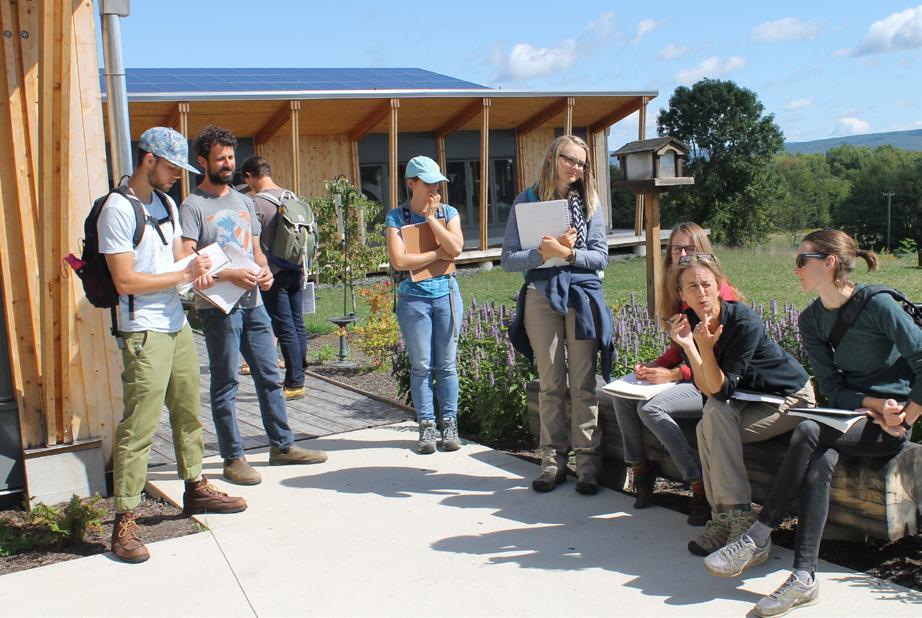

• Through the completion of community-based projects, the students facilitate discussions around climate impacts and how planning and design can provide opportunities for mitigation and adaptation.
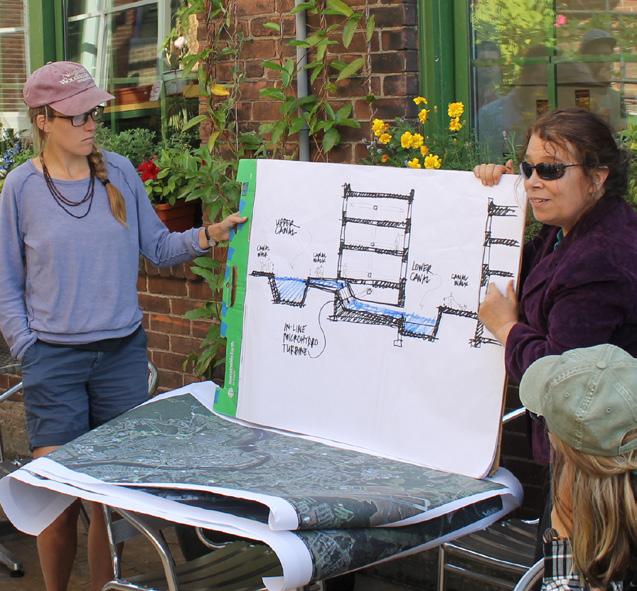
Operating a School with Climate in Mind
In addition to its focus on climate change in the curriculum, Conway continues to seek opportunities to reduce greenhouse gas emissions and increase equity in its operations. The School is analyzing investments to more closely examine divestment from fossil fuel industries. The School chose to renovate an existing building for its campus rather than building anew, and maximized energy efficiency, durability, and indoor air quality in the retrofit. Conway uses its social media and other marketing channels to share information about climate policy advocacy.
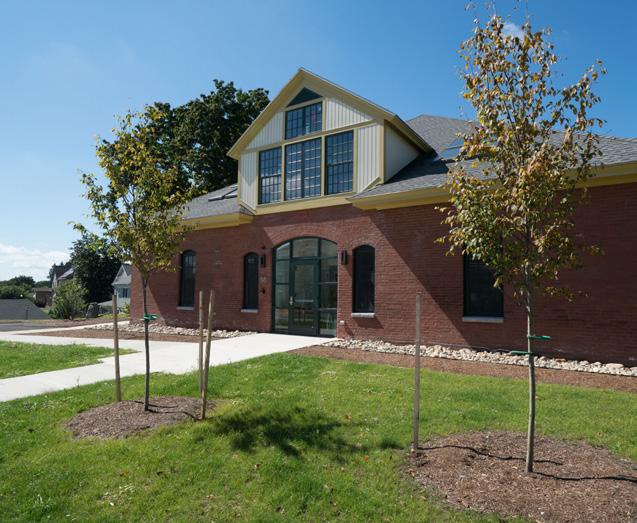
The Conway School | 4
Professor Kim Erslev (right) talks with the Class of 2019 about historical and contemporary use of hydropower in the city of Holyoke, MA.
Students visit the Hitchcock Center, a living building.
Professor Bill Lattrell discusses floodplain ecology with students.
The Conway School occupies a historical building, formerly part of the Northampton State Hospital. The building is an example of adaptive reuse and mixed use development.
Visiting Speakers
Challenging Paradigms
Conway’s program encourages students to critically examine established beliefs and paradigms in academic fields of study and professional practice. The visiting speaker series catalyzes these conversations, particularly around climate change and equity. Speakers may include municipal planners, research scientists, landscape architects, ecologists, sustainability and resilience program managers, engineers, historians, farmland planners, and more.
Dr. Tracy A. Corley, Director of Research and Partnerships at the Conservation Law Foundation , spoke with students about equitable infrastructure: “if you take care of people, you take care of the planet.” The actions and systems that contribute the greatest to global warming depend upon their ability to exploit people. How can we, as designers and planners, but also as community members, challenge these actions and systems?
Adrian Smith, Staten Island Capital Projects Team Leader within the New York City Department of Parks and Recreation , noted the need for landscape architects to reach out to mayors and local governments to encourage climate action.

Dr. Danielle Perry, Coastal Resilience Program Director at Mass Audubon , reminded students that people think of resources in different ways, and that we need to understand what they value and how. Her climate vulnerability assessments include both climate change impacts to natural communities, like salt marshes, and how these impacts will affect human communities that value them.
Dr. Brian Donahue, Professor of Environmental Studies at Brandeis , shared his research on increasing local food production in New England, and stressed the importance of living wages, affordable healthcare, ecosystem service incentives, and regulations.

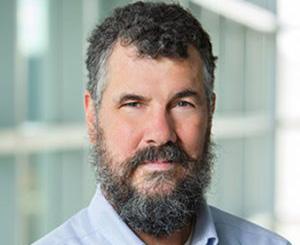
Daphne Lundi, Deputy Director for Social Resiliency at the NYC Mayor’s Office of Climate Resiliency , stressed social cohesion as a critical component of climate resilience. Climate change has a crippling effect on public health, and building strong social networks through shared community spaces (libraries, open spaces) is critical to survival.
Neha Savant, Wildlife and Fisheries Ecologist with the NYC Department of Parks and Recreation , reminded us that all environmental projects are political problems. Being a scientist (or a designer) means taking sides: neither field is entirely subjective.



Dr. April Baptiste, Professor of Environmental and Africana and Latin American Studies at Colgate University , discussed how knowledge does not consistently predict behavior. In her work with Caribbean communities experiencing sea level rise, she seeks to understand peoples’ beliefs, values, and attitudes.


The Conway School | 5
The Class of 2022 engages in a conversion with historian, writer, and horticulturist Abra Lee.
Conway Graduates Working on Climate Issues Now City Planning, Ecological Restoration, Food Production, and More
The impacts of climate change are here: rising sea levels, inland flooding, droughts that impact food systems, heat waves and deep freezes, water supply shortages. Conway prepares students to understand and design both in anticipation of and response to these impacts. Each year, new students come to Conway more deeply concerned about the future for their generation and the world; at Conway they work on three real projects with climate change in mind, and they leave with the teamwork and multidisciplinary skills to continue making an impact on climate mitigation, adaptation, and resilience. Our alums—from every decade—are deeply involved in climate work as designers, planners, and activists.
More Conway Alums Addressing Climate Change in their Work:




• Seth Wilkinson ’99, Founder, President, and Restoration Ecologist, Wilkinson Ecological Design
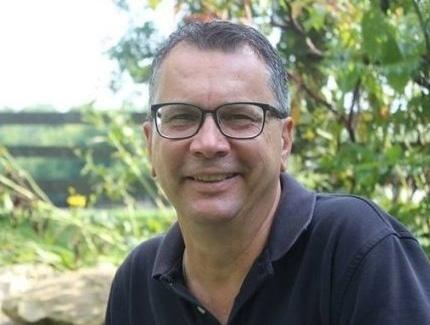

• Erik Van Lennep ’83, Climate Innovator, TEPUI Design
• Sue Reed ’87, Author, ClimateWise Landscaping: Practical Actions for a Sustainable Future with co-author Ginny Stibolt
“My work involves overseeing, designing, and implementing large scale projects for the managed realignment of dykelands in Atlantic Canada to assist with climate change adaptation and tidal wetland restoration along vulnerable coasts.”
“There’s no sole owner of any project and challenging the status quo means collaboration to reach innovation. My work involves creating that synergy so we can move that needle together from big picture ideas to the tiny details.”
“A fundamental way to address many of the issues we confront as a society today is to use the land and properties we already have more thoughtfully. GoodLands provides the... implementation tools for the Catholic Church to leverage its landholdings to address pressing issues.”
Liz
“We work to promote regenerative development, sustainable land use patterns, and community and land stewardship through site design, comprehensive planning, and regulatory initiatives.”
Jim
“My position is incredibly diverse including economic development, stormwater and floodplain management, and land-use and regulatory policy.”
“Our work involves developing personal and regenerative relationships to places, whether clients are companies looking for regeneratively sourced raw materials, or farmers and landowners with a more ‘hands on’ relationship to their land.”
The Conway School | 6
Molly Burhans ’15, Founder, GoodLands (NY)
Øystein Kristiansen ’17, Design Associate, Terra Genesis (Norway)
Samantha Battaglia ’17, Restoration Designer, CBWES (Nova Scotia)
Taurean Gagnon ’18, Landscape Designer, OLIN (PA)
P. Urban ’89, Director, Oldham County Planning (KY)
Kelly ’14, Project Planner, Resilience Planning & Design (NH)
>>Join the conversation at csld.edu















 By Dana Maple Feeney, Boris Kerzner, Shaine Meulmester ‘20.
By Dana Maple Feeney, Boris Kerzner, Shaine Meulmester ‘20.



















